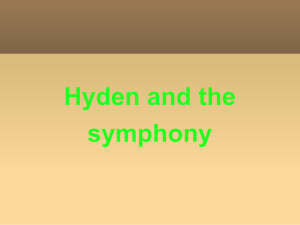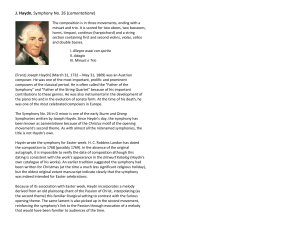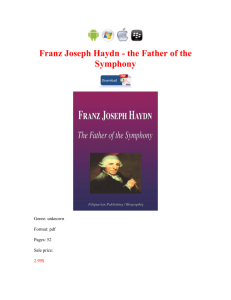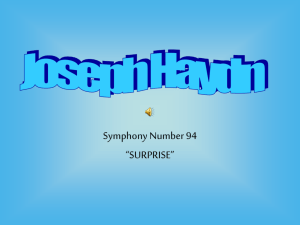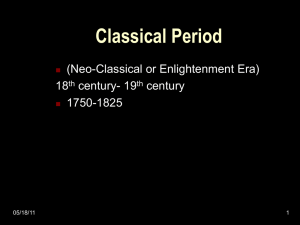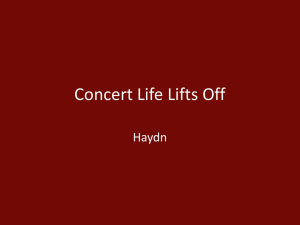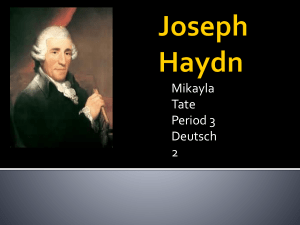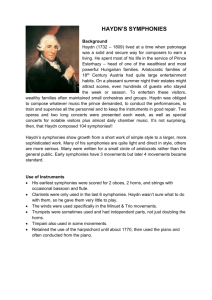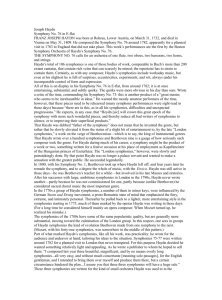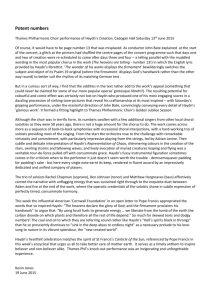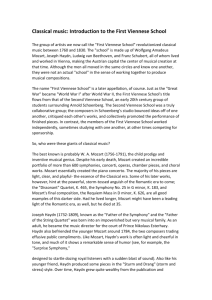Hye-Jin Kim - Minnesota Sinfonia
advertisement
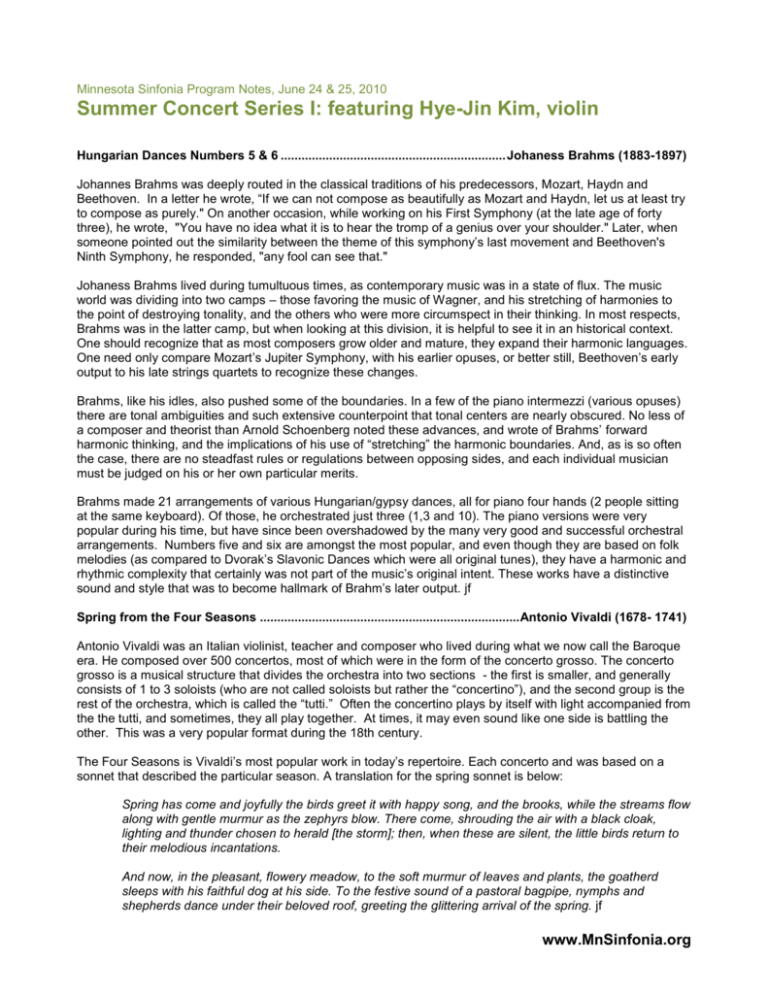
Minnesota Sinfonia Program Notes, June 24 & 25, 2010 Summer Concert Series I: featuring Hye-Jin Kim, violin Hungarian Dances Numbers 5 & 6 ................................................................. Johaness Brahms (1883-1897) Johannes Brahms was deeply routed in the classical traditions of his predecessors, Mozart, Haydn and Beethoven. In a letter he wrote, “If we can not compose as beautifully as Mozart and Haydn, let us at least try to compose as purely." On another occasion, while working on his First Symphony (at the late age of forty three), he wrote, "You have no idea what it is to hear the tromp of a genius over your shoulder." Later, when someone pointed out the similarity between the theme of this symphony’s last movement and Beethoven's Ninth Symphony, he responded, "any fool can see that." Johaness Brahms lived during tumultuous times, as contemporary music was in a state of flux. The music world was dividing into two camps – those favoring the music of Wagner, and his stretching of harmonies to the point of destroying tonality, and the others who were more circumspect in their thinking. In most respects, Brahms was in the latter camp, but when looking at this division, it is helpful to see it in an historical context. One should recognize that as most composers grow older and mature, they expand their harmonic languages. One need only compare Mozart’s Jupiter Symphony, with his earlier opuses, or better still, Beethoven’s early output to his late strings quartets to recognize these changes. Brahms, like his idles, also pushed some of the boundaries. In a few of the piano intermezzi (various opuses) there are tonal ambiguities and such extensive counterpoint that tonal centers are nearly obscured. No less of a composer and theorist than Arnold Schoenberg noted these advances, and wrote of Brahms’ forward harmonic thinking, and the implications of his use of “stretching” the harmonic boundaries. And, as is so often the case, there are no steadfast rules or regulations between opposing sides, and each individual musician must be judged on his or her own particular merits. Brahms made 21 arrangements of various Hungarian/gypsy dances, all for piano four hands (2 people sitting at the same keyboard). Of those, he orchestrated just three (1,3 and 10). The piano versions were very popular during his time, but have since been overshadowed by the many very good and successful orchestral arrangements. Numbers five and six are amongst the most popular, and even though they are based on folk melodies (as compared to Dvorak’s Slavonic Dances which were all original tunes), they have a harmonic and rhythmic complexity that certainly was not part of the music’s original intent. These works have a distinctive sound and style that was to become hallmark of Brahm’s later output. jf Spring from the Four Seasons ........................................................................... Antonio Vivaldi (1678- 1741) Antonio Vivaldi was an Italian violinist, teacher and composer who lived during what we now call the Baroque era. He composed over 500 concertos, most of which were in the form of the concerto grosso. The concerto grosso is a musical structure that divides the orchestra into two sections - the first is smaller, and generally consists of 1 to 3 soloists (who are not called soloists but rather the “concertino”), and the second group is the rest of the orchestra, which is called the “tutti.” Often the concertino plays by itself with light accompanied from the the tutti, and sometimes, they all play together. At times, it may even sound like one side is battling the other. This was a very popular format during the 18th century. The Four Seasons is Vivaldi’s most popular work in today’s repertoire. Each concerto and was based on a sonnet that described the particular season. A translation for the spring sonnet is below: Spring has come and joyfully the birds greet it with happy song, and the brooks, while the streams flow along with gentle murmur as the zephyrs blow. There come, shrouding the air with a black cloak, lighting and thunder chosen to herald [the storm]; then, when these are silent, the little birds return to their melodious incantations. And now, in the pleasant, flowery meadow, to the soft murmur of leaves and plants, the goatherd sleeps with his faithful dog at his side. To the festive sound of a pastoral bagpipe, nymphs and shepherds dance under their beloved roof, greeting the glittering arrival of the spring. jf www.MnSinfonia.org Zigeunerweisen (Gypsy Airs) opus 20 .......................................................... Pablo de Sarasate (1844-1908) Pablo de Sarasate was one of the many 19th century violin virtuosos who was known not only for his dazzling technique, but who also was responsible for many of the show pieces in today’s repertoire. He approached many of the day’s leading composers, requesting concertos and concert pieces for him to play. At the age of fifteen, when he first approached Camille Saint-Saens, the French composer recollected that the violinist was “fresh and young as spring itself, the faint shadow of a mustache scarcely visible on his upper lip, he was already a famous virtuoso.” Not only did Sarasate commission new works, but like many other virtuosi of the time, he wrote music for himself to play, as his own public vehicle. There was of course a long tradition of composers writing music for their own performance – Bach, Mozart and Beethoven to name of few of the great masters. But performers such as Sarasate, Pagannini and Liszt changed the tenor, by creating works that were fiendishly difficult, and showed off their technical prowess all but to a fault. The Gypsy Airs was composed in 1878, and premiered that same year in Leipzig. It is the best known and most popular of Sarasate’s approximate output of sixty compositions. Loosely based on the Hungarian folk dance form of the Czardas, it is has a slow and stately introduction, which sounds improvisational and allows for grand melodic and emotional jesters. What comes next is a rhythmically driven and technically demanding fast section, which of course references gypsy dances. When describing Sarasate’s performances, famous author and music critic George Bernard Shaw wrote that it left criticism gasping miles behind him. jf Symphony No. 94, The Surprise ................................................................ Franz Joseph Haydn (1732-1809) Franz Joseph Haydn is commonly known as the father of the classical symphony. Because he had the luxury of consistent financial security, and the opportunity to work with quality musicians over a long period of time, he was able to develop slowly and methodically as a composer and craftsman. Haydn spent the years of 1761 to 1790 in the employ of Esterhazy family – first with Paul Anton, and after his death, his brother Prince Nicolaus. Nicolaus (who had the longer tenure) loved music, and was very supportive of Haydn and his efforts. Nicolaus employed excellent musicians and singers, which gave Haydn a marvelous laboratory to develop and sharpen his compositional skills. The Esterhazy estate, which was described by a French traveler as “having no place but Versailles to compare with for magnificence,” became a center for excellent music making and productions. At first Haydn’s orchestra was small (his early symphonies generally used few winds and a small string compliment), but over time the size of the orchestra grew, as did the proficiency of its players. Haydn’s composing mirrored these changes. The complexities and the lengths of his symphonies increased, and he made more technical demands on his players. Over this time frame, the typical four-movement classical symphony format became formalized, largely because of the development of his compositions. Haydn’s fame spread across Europe, and after the death of his patron Prince Nicolaus, he was very much in demand. He was brought to England two times by the impresario Johann Peter Salomon, who commissioned him to compose a total of twelve symphonies for the London audiences. These twelve symphonies (numbers 92-104), which are referred to as the London Symphonies, or the Salomon Symphonies are considered to be the pinnacle of the classical symphonic form, and the best of Haydn’s enormous symphonic output. Many of these symphonies have nicknames, somehow related to the musical content. Examples include the Drumroll because of the opening roll in the timpani, the Clock, because of a “ticking” rhythm in the slow movement and the Miracle because of a chandelier falling during a performance, and no one being hurt by the accident. Other symphonies have specific associations, such as the Oxford, because Haydn was awarded an honorary doctorate at one of the town’s universities. In the case of the symphony on this program, the relationship is the loud “wake-up chords” of the second movement. jf www.MnSinfonia.org
